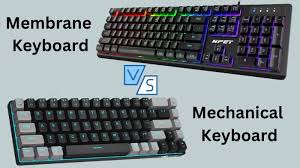The type of key switch used in a keyboard plays a crucial role in the overall typing experience. Understanding the differences between mechanical and membrane key switches can help you make an informed choice.
1. Mechanical Key Switches: Mechanical keyboards use individual switches for each key, which can be categorized into different types based on their actuation mechanism. Common types include:
- Cherry MX Red: Linear switch with a smooth keystroke.
- Cherry MX Blue: Tactile and clicky switch with audible feedback.
- Cherry MX Brown: Tactile switch with a quieter sound. Mechanical switches offer durability and precise feedback, making them popular among gamers and typists.
2. Membrane Key Switches: Membrane keyboards use a rubber or silicone dome under each key that collapses when pressed. This type of switch is generally quieter and less expensive. Membrane keyboards tend to have a softer feel and require more force to actuate compared to mechanical switches.
3. Typing Feel and Feedback: Mechanical keyboards provide distinct tactile feedback, allowing users to feel the actuation point. This feedback can improve typing speed and accuracy. Membrane keyboards, on the other hand, offer a softer and quieter typing experience, which can be less fatiguing for prolonged use.
4. Durability and Longevity: Mechanical keyboards are known for their durability, with switches rated for tens of millions of keystrokes. Membrane keyboards typically have a shorter lifespan due to the wear and tear of the rubber domes.
5. Price and Value: Mechanical keyboards generally come with a higher price tag but offer better build quality and performance. Membrane keyboards are more budget-friendly and suitable for casual use.
Conclusion: Both mechanical and membrane keyboards have their advantages and drawbacks. Your choice will depend on your typing preferences, budget, and intended use.

